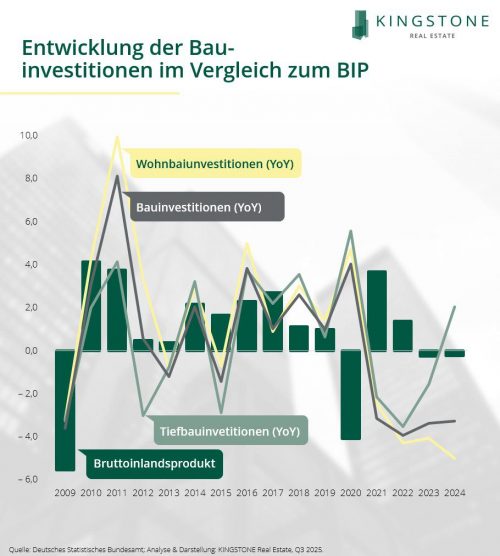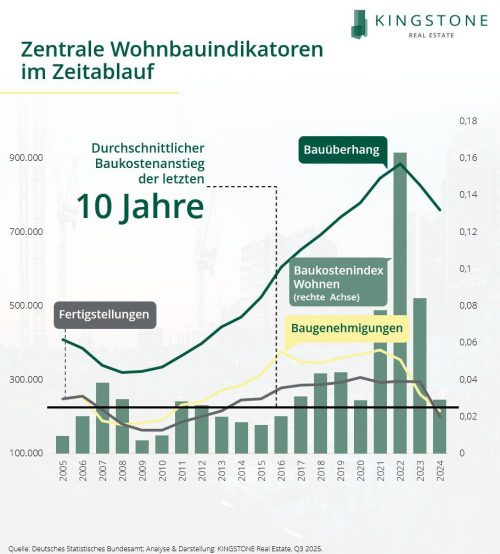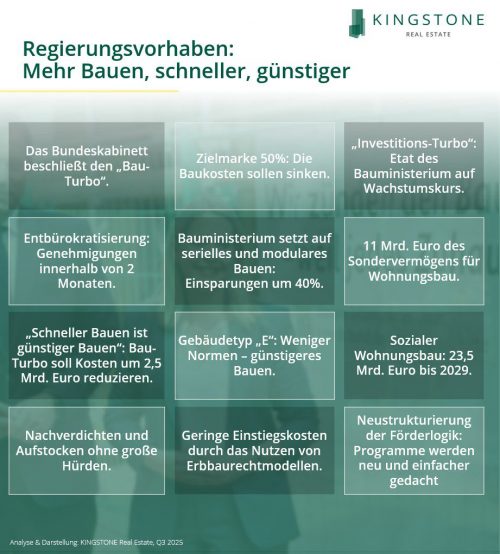Construction industry as a problem child of the German economy – times without a turnaround?

Introduction
Our junior analyst Amelie Feye has analysed the current situation in the German construction industry. The focus is on economic development, structural stress factors and political measures to stabilise residential construction. The evaluation provides a well-founded inventory and shows which adjusting screws could be relevant for a possible trend reversal.
Economy: Short recovery, no turnaround
In the first quarter of 2025, GDP increased slightly by +0.4% – fuelled by one-off pull-forward effects in foreign trade. As the year progresses, however, the momentum flattens out: industry, consumption and construction remain under pressure. For the year as a whole, economic institutes expect a meagre +0.3%, and a noticeable recovery is not expected until 2026.

From economic anchor to structural weak point
For years, the construction industry was a reliable stabiliser of the economy. Until 2019, construction investment and GDP developed largely synchronously – economic fluctuations were reflected in both variables without fundamentally decoupling from each other.
However, with the pandemic-related slump in economic output in 2020, a new dynamic set in: while GDP fell significantly, construction activity remained stable. Low interest rates, government support programs and continued high demand for residential construction even led to an increase in construction investment.
From 2021 onwards, the ratio was reversed: GDP recovered and settled at a stagnating level, while construction investment, on the other hand, declined noticeably from 2022 onwards. This opposite development points to an increasing structural weakness in the industry.
In the first quarter of 2025, there was a slight increase in construction investment of 0.5% on the previous quarter, but the year-on-year decline remains of –1.0%. In addition, there is a clear spread within the industry: While civil engineering is stabilized by public investment, residential construction in particular is coming under increasing pressure.
„50% less construction costs are just as ambitious as Klara Geywitz’s 400,000 apartments once were. Verena Hubertz relies on speed and standardization – whether the construction turbo ignites will be seen in practice.“
Amelie Feye
Junior Analyst (KINGSTONE Real Estate)

Demolition for permits, traffic jam for completions
Between 2021 and 2024, the number of building permits fell from around 380,000 to just 216,000 – a decline of 43% in three years. Although initial figures for 2025 indicate a possible bottoming out (+3.7% by April), the increase mainly affects single-family homes; there is stagnation in the important construction of apartment buildings.
The number of completions follows with a delay: in 2024, only 251,000 apartments were completed – a minus of 14%. The so-called construction backlog – approved but not realised – remains at a high level of around 760,000 units. Declines are not an expression of higher construction activity, but the result of project tasks and expired permits. In 2024 alone, around 29,000 permits expired.
The figures show that the problems in residential construction do not only start with planning – they are exacerbated in implementation. The structural barriers range from costs to a shortage of skilled workers to lengthy processes along the entire value chain.
The inertia of the system: What slows down construction projects today
Residential construction is under massive cost pressure: construction prices have risen by over 35% since 2020 – driven by material and energy price increases as well as higher wages. Although the momentum has weakened somewhat, the high price level remains. At the same time, financing costs have multiplied: construction interest rates are now 3.5–4% – after in some cases below 1% by 2021. This means that many projects are no longer profitable, especially not for institutional investors with clear return targets.
To make matters worse, the average construction time has risen from 20 to 26 months – as a result of persistent shortages of skilled workers and structural frictions. The result: a growing gap between approved and implemented projects.
The demand is unbroken: According to the BBSR, around 320,000 apartments would have to be built annually. But this goal is not even close to being achieved. For 2025, the ifo Institute expects only around 205,000 completions – and the trend is still falling. The situation is particularly tense in growth regions and increasingly also in medium-sized centres such as Erfurt or Rostock. At the same time, there are selective overhangs – for example in parts of Kassel or Saarbrücken. Without differentiated city scoring and precise allocation, there is a risk of a structurally dysfunctional housing policy.
Looking at Europe: Germany under particular pressure
The number of housing completions is falling in almost all European countries – especially sharply in countries with high construction costs and higher interest rates. According to EUROCONSTRUCT, Germany is at the bottom of the list with -30%, only Finland, Sweden and Denmark recorded even stronger slumps. While markets such as the UK (–13%) and France (–17%) are getting off comparatively lightly and in some cases expect a recovery from 2026, Germany remains the problem child, according to the ifo Institute: By 2027, there is a threat of a decline in completions of –44% to just 165,000 units. A trend reversal is not in sight.
Housing shortage meets boom in demand – conurbations under pressure
In high-growth cities, persistently high demand meets too little new construction – especially in the lower and middle price segments. As a result, asking rents in large cities have risen by almost 50% in ten years, and in Berlin even more than twice as high. Nationwide, the basic rent burden is Ø 28%, in many cities over 40%. Affordable housing is becoming a scarce resource – and a political focal point.

Planning in a hurry: The new course of construction policy
With the “construction turbo”, the federal government wants to accelerate housing construction: In the future, approvals will be possible in a maximum of two months – through simplified procedures and deviations from planning law. According to the Ministry of Construction, up to 2.5 billion euros could be saved, especially in administrative costs. The principle: “Faster construction is cheaper construction.”
Construction Minister Verena Hubertz has formulated a clear, ambitious goal: to reduce construction costs by up to 50%. To this end, it relies on serial and modular construction methods, the functional building type E and the new Hamburg Standard, which is intended to save up to €2,000/m² through the waiver of standards and simplified processes – without sacrificing safety or comfort.
Hubertz will have to be measured by this figure – a situation reminiscent of her predecessor Klara Geywitz : She had made headlines with the goal of 400,000 new apartments per year – and ultimately failed due to the reality of the market. The new attempt is no less ambitious, and expectations are correspondingly high.
The package is flanked by the increased use of heritable building rights to curb land costs and secure municipal land reserves. Despite a slight drop in land prices, many owners remain with inflated price expectations – a hurdle that can hardly be overcome without structural intervention.
For the first time, there are now also concrete financial commitments: 11 billion euros in subsidies are available – including 3.5 billion (2025) and 4 billion (2026) for social housing, as well as 1.75 billion each for the “Climate-friendly New Construction” programme. Whether this is enough depends largely on how quickly and effectively these funds can be transferred to structural implementation.
Final Reflection & Outlook
The housing shortage continues to worsen – especially in metropolitan areas with high demand and too little new construction. Affordable housing has become a social issue – and the political pressure to act is growing.
With the 11 billion euro package, the German government has sent a signal. But in a European comparison, it remains manageable: Great Britain, for example, mobilizes many times more resources. It remains questionable whether serial construction methods, building type E and heritable building rights will actually lead to the hoped-for cost reductions – because central drivers such as land prices, a shortage of skilled workers and excessive regulation continue to exist.
Important impulses – such as tax incentives, better depreciation regulations or interest subsidies – have so far been missing. Without these levers, investment momentum will fail to materialize. The first effects could become apparent from 2026 onwards – provided that programmes take effect, approvals accelerate and local actors follow suit. In the long term, more is needed than subsidies: namely, political reliability, regulatory simplification and the firm will to make housing affordable again – as an economic foundation and social obligation at the same time.
***
Über KINGSTONE Real Estate
KINGSTONE Real Estate ist ein institutioneller, eigentümergeführter Immobilieninvestmentmanager und bietet eine Bandbreite an Produkten und Anlagestrategien in den Märkten Deutschland und Zentraleuropa, welche das ganze Renditespektrum von Core bis Opportunistisch abdecken. Unser Fokus liegt hierbei auf ESG-Produkten in den Bereichen Wohnen, Büro und Gesundheit. Darüber hinaus können wir auch Investmentlösungen im Bereich Real Estate Debt anbieten.
Mehr Informationen unter: www.kingstone-re.com
***
Ansprechpartner
Maximilian Radert
E: research@kingstone-re.com


